 Any true animation fan is aware of how those relentless pencil jockeys lampooned each other daily with gag sketches. Tony Creazzo saved a box-full of these drawings, mostly from Pelican Films. His son Paul sent me digital copies. They are unsigned, so we can only guess as to whom, exactly, drew which ones. But it will be an educated guess, at least.
Any true animation fan is aware of how those relentless pencil jockeys lampooned each other daily with gag sketches. Tony Creazzo saved a box-full of these drawings, mostly from Pelican Films. His son Paul sent me digital copies. They are unsigned, so we can only guess as to whom, exactly, drew which ones. But it will be an educated guess, at least.
Please bear in mind that these were done by a bunch of old-school White guys before political correctness became a concept, but they were cartoonists, and no offense must have been intended. For example, a simple remark that Armin Shaffer was in hot water for losing his union card might have prompted:

Or perhaps someone suggested he’d be eaten alive at the next meeting. Don’t know who created it, but that’s Armin Shaffer.

Tony Creazzo was Armin Shaffer’s Assistant Animator at Pelican Films. Shaffer was a west coast guy trained at Disney. He also assisted Tex Avery at M-G-M. Shaffer worked on WINKY THE WATCHMAN for Hugh Harmon. In 1954 John Sutherland Productions sent Shaffer to the Big Apple when they opened a branch at 404 Fourth Avenue. Tony Creazzo became Armin Shaffer’s assistant. Shaffer and Creazzo soon went over to Chad Associates. Creazzo may have drawn the two portraits of Armin Shaffer shown above. At the very least, he saved them in a box.
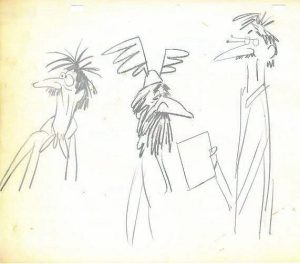 Tony Creazzo was New York bred, rising up through the inbetweening pool at Terrytoons. Creazzo got caught up in a mass firing when Terry tried to cleanse his shop of union advocates. Creazzo landed at Famous Studios. Moonlighting brought Creazzo to Shamus Culhane Productions, where he got to know John Ployardt.
Tony Creazzo was New York bred, rising up through the inbetweening pool at Terrytoons. Creazzo got caught up in a mass firing when Terry tried to cleanse his shop of union advocates. Creazzo landed at Famous Studios. Moonlighting brought Creazzo to Shamus Culhane Productions, where he got to know John Ployardt.
This Ployardt guy used to be “John McLeish”. As such, he got to Disney by 1939 and voiced the Carnival Barker in PINOCCHIO. McLeish narrated DUMBO; THE RELUCTANT DRAGON; and a decade of GOOFY shorts. He even came up with the story for one GOOFY film. McLeish also did research and project development on the Evolution sequence of FANTASIA, bringing him into the sphere of union activists John Hubley, Dave Hilberman, and Zack Schwartz. When those three were ousted by Disney and gone to Columbia’s Screen Gems, McLeish followed as a writer, though Disney still used him for voice work.
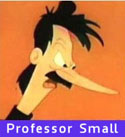 At Screen Gems, McLeish wrote and performed the character Professor Small, upon which the model sheet above is no doubt based. In 1949 he was credited as John Ployardt for his work on Disney’s THE WIND IN THE WILLOWS. McLeish finished his last GOOFY in 1951, became full-time Ployardt, and headed for New York with Lars Calonius to form Archer Productions.
At Screen Gems, McLeish wrote and performed the character Professor Small, upon which the model sheet above is no doubt based. In 1949 he was credited as John Ployardt for his work on Disney’s THE WIND IN THE WILLOWS. McLeish finished his last GOOFY in 1951, became full-time Ployardt, and headed for New York with Lars Calonius to form Archer Productions.
McLeish/Ployardt next reunited with Dave Hilberman at Tempo Productions. After Tempo became Academy in 1954, John Ployardt went to work for Shamus Culhane, where he orbited around Jack Dazzo and Tony Creazzo, who knew each other from Famous Studios. And, of course, they codified each other into recognizable cartoon characters for an on-going series of insider jokes. Armin Shaffer was rendered thusly:
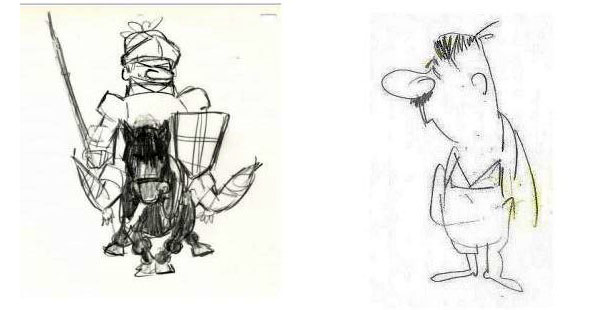
That’s him in that stew-pot. Tony Creazzo became:
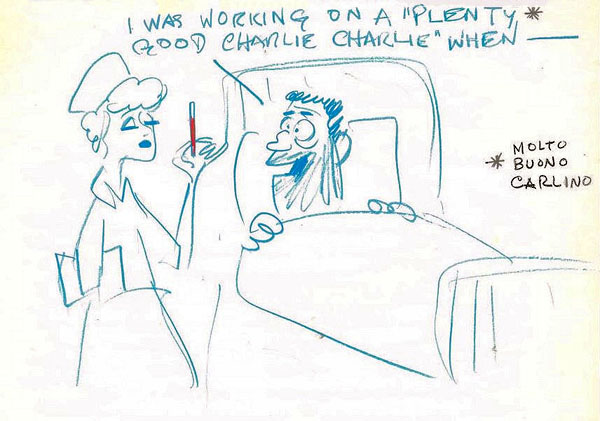
And so. a trio of goofballs placed each other in all sorts of scenarios:



On a less intelectual note, they could be mobsters:
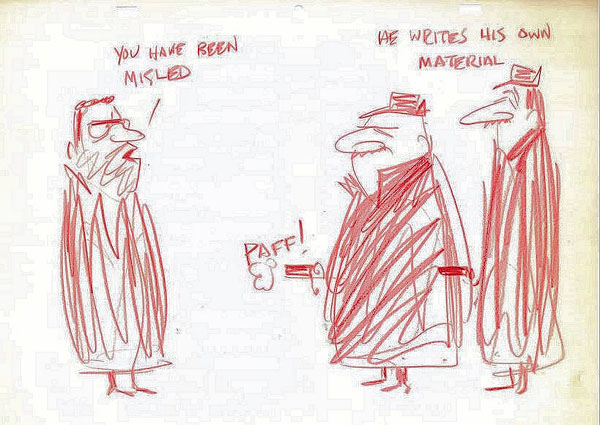

Or Renaissance Men:


They could be anybody, anywhere, any-when:


Tony Creazzo was working at UPA when John Sutherland Productions opened a New York branch to do television commercials. Sutherland hired Creazzo away from UPA, and I believe he created the cartoon below about Shaffer. John Sutherland Productions was a hotbed of Conservatism, known for theatrical cartoons promoting Capitalism. They did the Chiquita Banana ads for the CIA front United Fruit. Communist Russia was the enemy at Sutherland Television.

This Nikita Banana joke turns the whole Cold War paradigm on its head. Bananas seem to be an on-going theme. I’m not sure who ‘Jack’ is, possibly someone back in Hollywood at either Disney or M-G-M. Perhaps Jack Zander, owner of Pelican Films. It may also be Jack Dazzo, who occassionally pops up in this mix.
Dazzo is definitely the third bird in this parody of R. O. Blechman’s classic CHRISTMAS BIRDS station ID for CBS.

In another – Dazzo is attacked by Frankenstein’s Monster spouting Dracula’s dialogue.

Tony Creazzo and Jack Dazzo had been in various shops together, and both, likewise, with Phil Kimmelman. There’s a story about Kimmelman when he was an inker at Famous. Supervisor Nelly Sanborn Green gave Phil model sheets of a character, but Phil’s ink lines kept coming out too thick to match the delicate nuance of that model sheet. So Phil thickened the lines on the model sheet to match his, and got caught. Tony and Jack, both more seasoned pros, must have found that hilarious. I believe this next piece is from Jack Dazzo to Phil Kimmelman.

My further theory on this piece is that it is a take on sloppy model sheets where the character’s appearance is not uniform. Because the purpose of a model sheet is to make the character uniform from all angles.
Then there was the time that one of the ad agency guys tapped Armin Shaffer to be a Marlboro Man, hawking cigarettes on television and billboards:


This led to John Ployardt getting his own (fictional) billboard:

Apparently Ployardt had qualms with how he was drawn:

There were sketches of Creazzo and his duck-hunting dog:


Quotas on the number of pages that must be done every day provided fodder:

To be fair, most of these fellows were working double shifts, bouncing in-and-out of studios after their day shifts. Kimmelman told me a story about other animators waking Creazzo up when supervisors came around. Creazzo had been face down on the registration pegs. He talked with management while having peg-marks indented on his forehead.
Another aspect of the animated advertisement studios in that era was the rise of Designers. Whereas theatrical cartoons had relied on the familiar, this new teleblurb industry craved fresh meat. Designers developed complex compositions which were difficult and costly to animate. Just take a gander at a holiday car created by designer Cliff Roberts.

It was left to Animators to tame those wild designs into submission:

Is this one accussing Ployardt and Shaffer of being brown-nosers?

There were unsubstantiated rumors of an inter-office affair between Armin Shaffer and inker Violet Gelman:


It seems Armin Shaffer wass a virile, manly man;


A caring, loyal associate;


As well as a bit of a trickster!

Then there’s something about France:

And bananas!

Oh, and there’s a recurring caricature of this other guy:

He’s in a few:


Could this be the weird fellow confronting Bob Ebeling at Shamus Culhane Productions?
I have a theory as to the identity of this total doofus character – Emery Hawkins. In support of this theory, I present the following:
Born in an obsolete Arizona mining town, Emery Hawkins built his own animation set-up at age sixteen. That was around his Junior year in 1927. Straight out of North Hollywood High School, Emery started working for Walter Lantz on the Universal Studios lot. Then Charles Mintz at Screen Gems learned about Emery, who spent a while bouncing between Lantz and Mintz. So, by 1932 Disney obvioudly wanted to get a look at this young up=and=comer.
Hawkins evaded the trap many animators fell into, because he was restless. He moved about, playing musical chairs with the Hollywood shops. 1938 found Emery at M-G-M besides Friz Freleng, Milt Gross, Jack-Zander and Hanna-Barbera. Next year he was back at Disney on the DONALD DUCK unit, then some PLUTO, and some GOOFY (where John Ployardt narrated).
Hawkins returned to Screen Gems, where Frank Tashlin’s supervision style afforded freedoms unheard of in other shops. John Ployardt was there. So were John Hubley, Dave Hilberman, and Zack Schwartz. Then Dave Fleischer replaced Tashlin as supervisor and the fun slowed its roll. 1943 brought Hawkins back to Walter Lantz Productions to redesign WOODY WOODPECKER just as Shamus Culhane cut loose on a series of frantic cartoons there. Emery Hawkins animated for Culhane. With an interlude at Warner Brothers, Hawkins remained with Lantz a couple good years. Hawkins then went back to Disney and DONALD DUCK, then a couple years at WB again, heading for New York in 195O to join Jack Zander’s crew at Transfilm. He was soon at Archer Productions, where, in 1952, Lars Calonius had replaced John Ployardt as Art Director for the Cold War classic DUCK AND COVER, which was produced by John Sutherland. Hawkins returned to Hollywood with a desk at John Sutherland Productions.
In September of 1954 Hawkins ventured to New York again as part of John Sutherland Television Productions. Tony Creazzo was just arriving. Armin Shaffer was already there. Could this be the basis for:

Emery Hawkins quickly went back to Hollywood. He worked for Hubley’s Storyboard studio cross-country from California during 1957 to 1959. At that point Jack Zander’s Pelican Films made the same long-distant arrangement with Hawkins. Coincidentally, or not, Ployardt, Shaffer, and Creazzo were all with Pelican at that time. Hawkins sometimes travelled to NYC for meetings.
Now, anyone who’s seen a picture of Emery Hawkins must be convinced I’m crazy. He looks nothing like that drawing. But, could that be the joke? He’s so avarage looking that they redesigned Hawkins for comedic effect?
Or, maybe this guy isn’t even the same character as the other drawings. Nothing is signed or dated. These art pieces were not created for mass consumption. They were private asides among a group of people engaged in making art destined for public consumption. Teleblurbs were aimed at consumption, and every artist involved gave up parts of their own individuality to join the beehive group mind. Inkers, Cameramen, Animators, Colorists, Designers, all must adhere to a singular vision on each ad. So, in a way, each of these cartoons are from all of them to each other.
Some were crudely drawn:

Others are mini master classes in pencil-slinging:

Either way, they’re awesome. I hope more boxes of this sort of stuff turns up. If that last drawing taught me anything, it’s that ‘life would be worse without bananas’.


 BOB COAR made his way in this world as a muralist and sign painter, illustrating on just about every surface imaginable. A life-long fan of animation, he is currently searching for digital, or actual, copies of Top Cel.
BOB COAR made his way in this world as a muralist and sign painter, illustrating on just about every surface imaginable. A life-long fan of animation, he is currently searching for digital, or actual, copies of Top Cel. 









































I’ve commented before that Tempo didn’t “become” Academy. Tempo folded when Walter Winchell denounced its founder Dave Hilberman and sales director William Pomerance as Communists, and the firm subsequently lost all its clients. Academy was a Los Angeles-based company that opened its New York branch in the studio space that Tempo had occupied. They hired a number of former Tempo staffers like Pablo Ferro, but it was a different company with different management.
Years ago a Native American colleague told me that there was an old joke about how the “Fugowee” tribe got its name: they were wandering around lost in the wilderness until they encountered some settlers and asked them “Where the fuck are we?” This question was misinterpreted as the declarative statement “We’re the Fugowee!” My colleague said this joke inspired the name of the tribe in the sitcom “F Troop”, where it was bowdlerised into “Hekawi” (i.e., “Where the heck are we?”). So the cartoon shown here of Columbus (I think it’s supposed to be) with the Indian appears to be concrete evidence of the joke’s currency. It’s doubtful that it would have left any other record of itself.
I think some of the obscure references in these cartoons (e.g., the ones involving bananas) might come from other off-colour jokes that were going around at the time.
The disclaimer about “old-school White guys” provides some important context, but what exactly does it mean that these drawings are from a time “before political correctness became a concept”? Civil rights groups first started calling out animation studios for the ethnic caricatures during World War II. But even earlier, over a century ago–in 1917–cartoonist Bud Fisher was interviewed about his “Mutt and Jeff” becoming a film series, and he expressed sensitivity to ethnicity. He said, “Thinking up ideas for humorous cartoons is a very serious business.” When talking about how to choose “the right material” for cartoons, he noted, “Religion, politics, races of people, and various types of readers and audiences must be taken into consideration and treated according to their standards.” On ethnic humor he suggested, “The ridiculing or light handling of any particular race must be eliminated. For while using the negro as a butt for comedy might be popular in New England, in the South where the exhibitor is largely dependent on colored patronage, it would be very unwise.” He cautioned that, however difficult, the cartoonist’s job was to “make everybody laugh and offend no one.” [“Trials of a Cartoonist,” Motography (25 August 1917), 412.]
So, if Fisher said this in the 1910s, it means that even among cartoonists, there was always some awareness about the potential to offend. Sometimes, “before political correctness” is another way of saying “before distributors/tv networks became nervous about losing money on having to stop showing certain cartoons” or “before studios became more diverse and employees held each other more accountable for the caricatures.”
That style should have been the future of animation.
Emery Hawkins did not move to Miami; I don’t know where that information originates.
I thought I had seen it an an interview, but you must be right. I count on you all to keep me on track. I’ll have Jerry edit it.
If nothing else, these model sheets leave no doubt in my mind as to where Format Films’ design for Clyde Crashcup came from.
Bob, this post is amazing! I think everyone who works in animation for any length of time has a box of joke drawings. It’s the studio sport to blow off steam. Most of them make no sense out of context. Thanks for sharing this time capsule.
John Plyoardt/McLeish is an interesting dude and worthy of his own post. There’s a good story in Jack Kinney’s book about Ployardt calling to ask for a job, probably in 1950 (seems like he had been at Archer since 1949).
He worked in Disney’s commercial dept (and narrated another Goofy cartoon) until he was fired for living out of his office and returned to Archer in New York.
I love these crazy guys!